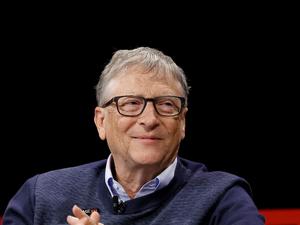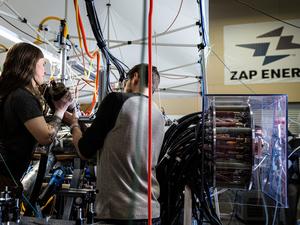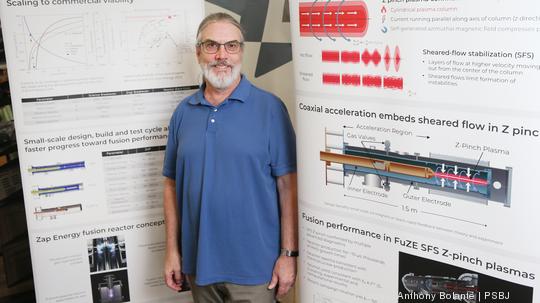
Brian Nelson, co-founder and chief technology officer of the fusion energy startup Zap Energy, had been a research professor at the University of Washington since 1987. Although he is still a research professor emeritus in electrical and computer engineering at UW, Nelson credits the government ARPA-E program, which funds early-stage energy technologies, for helping him move into the private sector three years ago.
“I started school in 1966 and left in 2019,” Nelson says. “I was on soft money and lucky enough to be useful enough.”
Zap Energy, which was founded in 2017, raised a $160 million Series C round in June. It is now part of a growing cohort of fusion energy companies in the Seattle area that have generated major funding over the past year. Everett-based Helion raised $500 million in November, while Tukwila-based Avalanche Energy raised $23.3 million in August.
The technology has proved elusive for decades, as fusion reactors hit temperatures of 150 million degrees Celsius, or 10 times hotter than the center of the sun, according to the Department of Energy’s Oak Ridge National Laboratory. Creating a facility to withstand the heat and pressure is a significant challenge.
The Business Journal spoke with Nelson about his career, the promise of fusion and his love of Frank Zappa.
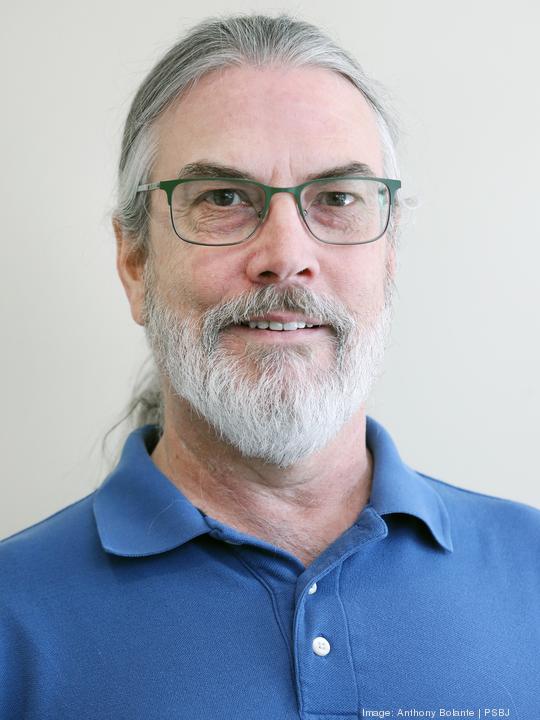
About Brian Nelson, CTO and co-founder of Zap Energy
- Age: 61 years old
- Hometown: Cedar Rapids, Iowa
- Current residence: Edmonds
- Education: Bachelor’s in electrical engineering at the University of Iowa, master’s in nuclear engineering at the University of Wisconsin-Madison, doctorate in nuclear engineering and engineering physics at the University of Wisconsin-Madison
- Interests outside of work: “I used to do a lot of hiking, but I think that was 30 years and 30 pounds ago. I have a nice pellet smoker. Now it’s more relaxing now that I have a house. You have to keep stuff up around it. My wife and I travel a bit.”
Explain fusion for dummies.
You take two small particles that are the same charge, and you get them hot enough that they’re traveling. Temperature is how fast they’re going, and if you get some of them that are going fast enough they can almost touch, they can undergo what’s called a strong nuclear force. They form a proto-nucleus, and then break into two pieces. Those come out with slightly less mass than went in, but E=MC², and C is a very large number, so that tiny little mass is multiplied by this giant number to give a lot of energy out.
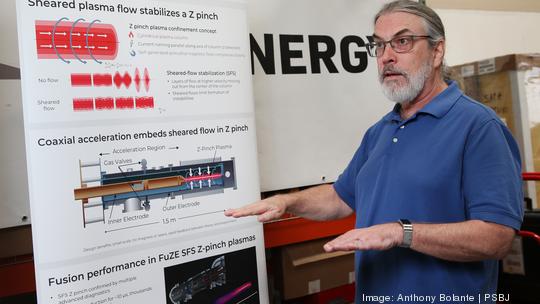
Fusion companies like Zap Energy and Helion have landed major funding over the past year. Why is fusion having its moment now? I think there’s a lot of interest in getting to a carbon-free energy economy. A lot of these investors, some are looking beyond the short-term gain and looking at the double-bottom line. They want to make money, but they also want to do something good for the environment. There’s all sorts of different investors that are interested in this. The interest and some of these larger fundraises have really shown a light on the issues.
How does being in the private sector compare to your time as a research professor?
What was really great at the university, especially on this research ... is we got to really dig in on the science on it, albeit on a smaller level, but it’s something that now we have the intuition on it. We know what to do and what not to do. We’re pushing here. We’re still doing science, but we still have to push hard on performance.
Fusion has proved elusive for decades. What’s different now that makes it more feasible?
Back in the ’70s when there was the oil embargo, there was a lot of money pushed into fusion. Imagine what you have with 1970s computers calculating things. Very smart people, but there’s a lot of hard things that computers can make easier. ... Fusion is still a long shot for everybody. It’s a very difficult thing to do, but there’s so many of these ideas that have never really been tried that I think people are willing to put some money up for a shot on goal. Some of them are quick to find out if it will work or not. What we like to say is if we bump into something, we can build something in a year.
Let’s say everything goes perfectly. What does our utopian fusion future look like?
We’re just a heat source that doesn’t have carbon emissions and has very inexpensive, almost limitless, fuel. I can imagine that the electricity, you wouldn’t have to worry about expanding present electricity. ... It won’t be Mr. Fusion Home Reactor in your DeLorean. There’s a lot of things you have to do with it, but it basically could literally replace the coal burner in a factory up to a point.
What is one thing most people don’t know about you?
I’m a Frank Zappa fan.
How did you get into that?
My older brothers had some albums back when I was a kid. They would let me listen to the cleaner stuff. I really enjoyed the music. It’s not a complete coincidence it’s called “Zap.”
This interview has been edited for length and clarity.

